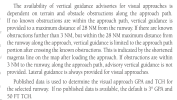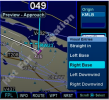The Garmin GTN650xi units have visual approaches. Presumably other models do also. Does anyone use this function routinely? What does it do? I loaded a visual approach on a few occasions but didn't get a glideslope. Where do you find it useful?
You are using an out of date browser. It may not display this or other websites correctly.
You should upgrade or use an alternative browser.
You should upgrade or use an alternative browser.
Garmin GTN650xi Visual Approach
- Thread starter FORANE
- Start date
I use it a lot and some but not all has glide slope. Helps me find them sometimes.
Last edited:
- Joined
- Mar 10, 2013
- Messages
- 19,562
- Location
- Oakland, CA
- Display Name
Display name:
Bro do you even lift
I use it often. Well I should say I dial in the visual often, don’t always fly it.
I use it often. Helps me make sure I have the correct airport / runway.
Last edited:
I am surprised sometimes that I get vertical guidance on a out of the way air strip.
Our airport you get it one way but not the other.
I don’t “fly it” but it sure is nice to have in your panel as a reference. Just like flying a IFR approach. Use it to help stay current for IFR. Imo
Our airport you get it one way but not the other.
I don’t “fly it” but it sure is nice to have in your panel as a reference. Just like flying a IFR approach. Use it to help stay current for IFR. Imo
Last edited:
It creates a straight in waypoint for a 3 mile final and a calculated 3° glidepath In most places.What does it do? I
I haven’t used it. I generally fly the pattern rather than a long straight in. If I need straight in guidance, I load an approach.
Last edited:
rangerz
Pre-Flight
I have the GTN 650 and at least along the northern gulf coast I haven’t found any airports yet where it doesn’t give glideslope. I don’t use it all the time but find it’s a useful reference especially if given a long straight in at a towered airport as an additional descent reference.
When using the visual approach be aware that if you load and activate the appr the GTN will prompt you to turn the CDI to a heading which is the RW heading. You must select the V3NM waypoint direct to get a vector to intercept the extended centerline at 3nm from the threshold. Obviously you could input a user WP further out and direct to it for more spacing or wait until you are flying your intercept angle before activating. When I first tried using the visual approach feature it was a little confusing until I realized this.
MooneyDriver78
En-Route
- Joined
- Aug 13, 2013
- Messages
- 4,692
- Display Name
Display name:
Tom
It creates a straight in waypoint for a 3 mile final and a calculated 3° glidepath In most places.
I haven’t used it. I generally fly the pattern rather than a long straight in. If I need straight in guidance, I load an approach.
You can still use it flying the pattern to get vertical guidance, could be helpful if you’re used to flying into a wide runway as opposed to a narrow one, or vice versa and perception is off.
- Joined
- Apr 23, 2013
- Messages
- 6,525
- Display Name
Display name:
3G
It creates a straight in waypoint for a 3 mile final and a calculated 3° glidepath In most places.
I haven’t used it. I generally fly the pattern rather than a long straight in. If I need straight in guidance, I load an approach.
My home drome (KSSF, Class D) is incredibly difficult to see at night. The two SIAPs (VOR 32, RNAV 32) are both to a runway that is unusable 90+% of the time due to prevailing winds out of the south and RWY 14 being the preferred runway. Both SIAPs are remarked at Straight In RWY 32 NA at night. Circling to 9, 32, and 14 NA at night.
I went out with a good CFI to specifically work on finding the airport at night when I moved to this airport a few years ago and thought maybe the Visual Approach feature might be useful. It is, but only if you’re arriving for a straight in, which I’m generally not, so usually get a downwind or base entry from tower.
Due to a shared D border with SKF, using the Visual for 9 or 14 isn’t really helpful for a right traffic. But on those rare occasions when I’m straight in 14, it’s worth it’s weight in gold.
I'll have to try it at my home airport. Home airport is difficult at night also.
Lighting is non-standard, aka it is poor.
Night operations are by prior permission only due to above and unlit mountains in the traffic pattern. The airport requires a night checkout.
Only one runway 6-24.
Departure at night is 24 only; landing is 6 only due to raising terrain also unlit.
The single instrument approach for 6 is NA at night.
The Garmin visual approach may be helpful at night.
Lighting is non-standard, aka it is poor.
Night operations are by prior permission only due to above and unlit mountains in the traffic pattern. The airport requires a night checkout.
Only one runway 6-24.
Departure at night is 24 only; landing is 6 only due to raising terrain also unlit.
The single instrument approach for 6 is NA at night.
The Garmin visual approach may be helpful at night.
From the Pilot GuideI have the GTN 650 and at least along the northern gulf coast I haven’t found any airports yet where it doesn’t give glideslope. I don’t use it all the time but find it’s a useful reference especially if given a long straight in at a towered airport as an additional descent reference.

You can. I can see using it for a straight in, particularly for a VFR-only pilot going into a towered airport. But once in a normal pattern, I really don't see how it would be useful unless you don't have a VASI or PAPI. At least I hope you don't need vertical guidance turning base to final 1 to 1.5 miles from the threshold. The issue with runway illusions - wide, narrow, upslope, downslope - are really flare to touchdown issues more than glidepath.You can still use it flying the pattern to get vertical guidance, could be helpful if you’re used to flying into a wide runway as opposed to a narrow one, or vice versa and perception is off.
It's just IMO, but I'm not impressed with a feature that looks like an incentive to super large patterns and straight in approaches.
Yeah, that pretty much rules out any vertical component at my airport. The LNAV doesn't even go below 1500 AGL.
BTW, for those interested in the feature, the Avidyne IFD version of the visual approach gives you an extended straight in approach also, but it also has reference overlays ( autopilots won't track those) for downwind and base. And there's some setup customization. You can specify the length of the final segment, the width of the traffic pattern, and the glidepath.


Using it in the pattern helps me square up the pattern at a glance.
- Joined
- Apr 23, 2013
- Messages
- 6,525
- Display Name
Display name:
3G
BTW, for those interested in the feature, the Avidyne IFD version of the visual approach gives you an extended straight in approach also, but it also has reference overlays ( autopilots won't track those) for downwind and base. And there's some setup customization. You can specify the length of the final segment, the width of the traffic pattern, and the glidepath.
View attachment 123838
Now that would be helpful for my use case. Brilliant.
TrueCourse
Line Up and Wait
- Joined
- Dec 10, 2019
- Messages
- 944
- Display Name
Display name:
TrueCourse
Be careful programming visual approach at night, especially to an airport you’re not familiar with. Make sure the 3 degree it programs is no less than what is normally required for that runway if doing an instrument approach.
- Joined
- Aug 18, 2017
- Messages
- 2,537
- Display Name
Display name:
Hang 4
I use it at unfamiliar airports for runway identification. If you have an MFD (G500, G3X), it will give you an extended centerline which is great for situational awareness and pattern entry. I never use the vertical track feature. If I need vertical guidance, I use an IR approach.
NordicDave
En-Route
Why not punch in an instrument approach flown in VFR conditions? You will be guided clear of obstacles at night.
rangerz
Pre-Flight
For airports that have LPV approaches that would generally be the preference. There are plenty that don't have them or any approaches at all, including my home airport.
